Role of Canals
In Japan nowadays, we can get water whenever we open the faucet thanks to the well-equipped network of canal facilities. But it was the fact that people depended upon the water well and rainwater before the canal facilities were well organized. Especially for agriculture, a vast amount of irrigation water was necessary, but farming management was highly dependent on rain, so the crop production was quite unstable because of unstable rainfall. To use limited water to the fullest extent for paddy rice cultivation people, especially, farmers, had a hard time getting water manually and implementing water-saving irrigation method such as "Kama-ue" method*.
To overcome such hardships our predecessors had and obtained stable water supply even when the river flow decreases, we had built the dams in the water source areas to secure water, the water intake to get enough water stably, and the canal systems to deliver and distribute water to the areas where it is in short supply and needed.
Here in this section, we will introduce the canal facilities in Japan.
*"Kama-ue" is a water-saving rice cultivation method to dig small holes in the rice paddy by using prods, so the water can stay there even when the entire rice paddy is unsaturated during the drought. Rice seedlings are planted in such holes where little water is left.
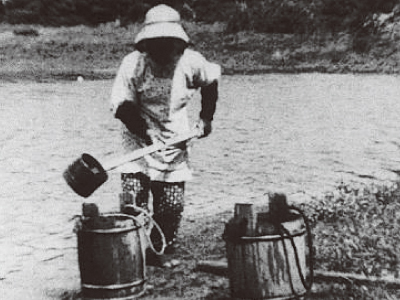
Manual water transport (carrying with buckets)
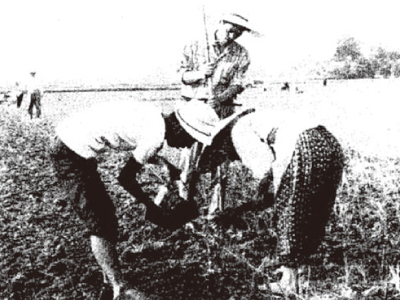
Rice planting by "Kama-ue" method
Different Types of Canals
Canals are generally classified into the following types: 1)an open canal, 2)a tunnel, 3)a conduit, 4)a siphon, 5)an aqueduct bridge, 6)drop structures (chutes), and 7)a pipeline. They are used depending on the topographical features on the route and social conditions. An "open canal" type has a free surface. Because of the difference in the gradient of the canal bottom, water goes from a higher position to a lower position by gravity. On the other hand, a "pipeline" type makes the water in the pipe flow down with the pressure from the pump or the water head pressure.
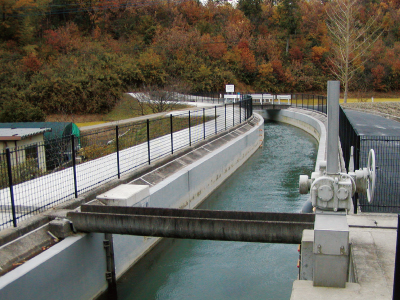
An open canal
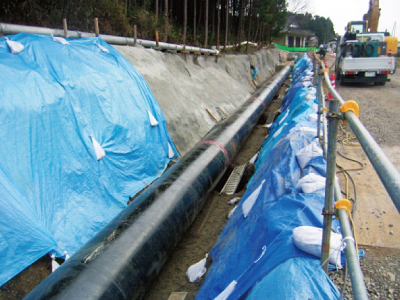
A pipeline
1) Open Canals
An open canal is classified into three types, i.e., an earthen canal, a lined canal, and a reinforced concrete canal.
Lined Canals
It is the canal built on the ground, excavated or banked and covered with lining material (concrete, etc.) to prevent erosion by water flow and make the surface durable and flat for smooth water flow.
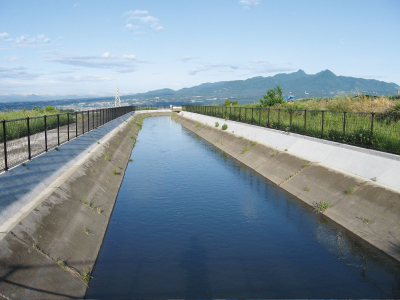
A lined canal
Reinforced concrete canals
It is a U-shaped reinforced concrete canal. The sidewalls of the canal are designed to stand water pressure of the canal water and pressure from the groundwater and the soil acts on the backside of the walls. This canal type applies to the narrower space compared to a lined canal.
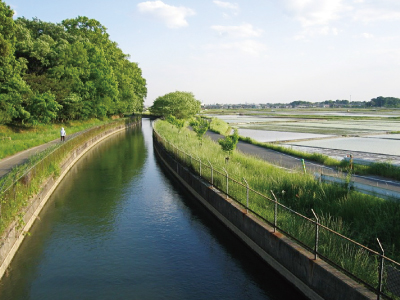
A reinforced concrete canal
2) Tunnels
A tunnel is used when water needs to be conveyed across the mountain or hilly area. And it is used if a route that circumvents the mountain area could be expensive, or the sufficient gradient for smooth water flow cannot be obtained.
To construct a tunnel, at least several dozen meters thick of earth covering or three times thick of earth covering of the tunnel section diameter is needed, depending on the geological condition of the ground, to prevent adverse effects on the ground surface right above the tunnel such as the ground subsidence.
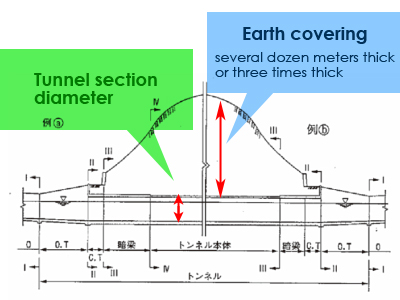
Schematic-cross section of a tunnel
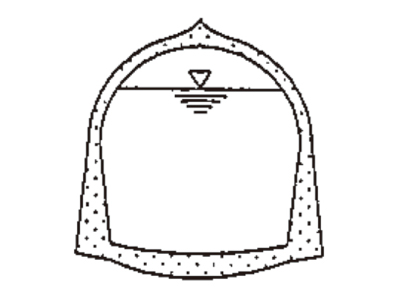
Cross section of a tunnel
3) Conduits
A conduit is buried underground and cannot be seen from outside. This canal type is employed especially when the upper part of the canal is used for the road. This conduit type is also employed in case topography of the canal route, land use, and groundwater level, etc. are not suitable for the open canal type, or the earth covering on the canal is too shallow for tunnel.

Cross-section of the conduit canal (A:Squire, B:Double-squire, C:Rectangular)
4) Inverted Siphons
An inverted siphon* is used when a canal needs to pass under a river, road, and railway, as those are difficult to remove to some other places. As the structure filled with water needs to stand the water pressure at all times, its water-tightness and strength are the two essential factors, especially for a siphon with a high elevation difference.
*Inverted siphon: Making use of the water level differences between an inlet and outlet of a siphon, water naturally flows down through an underground waterway.
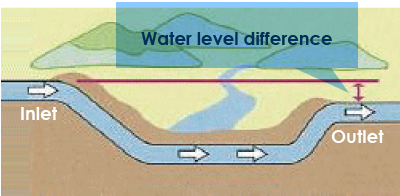
Schematic-cross section of an inverted siphon
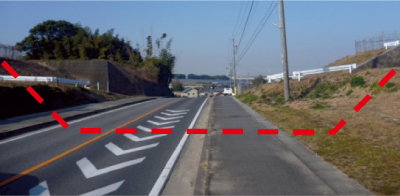
An inverted siphon crossing under the road
5) Aqueduct Bridges
An aqueduct bridge is used when a canal needs to pass over a river from the point of constraints of construction and economic efficiency or the necessary water level difference is not enough for an inverted siphon.
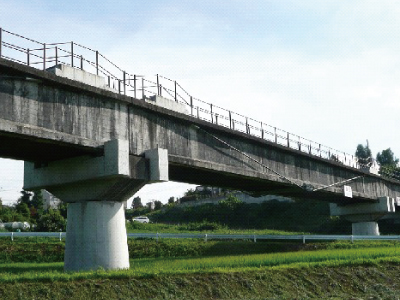
An aqueduct bridge
6) Drop structures (chutes)
Drop structures are built as the result of the selection of the canal route. Because of the topographical condition that requires a connection between the plateau and lowland, the drop structures are built to reduce the water force.
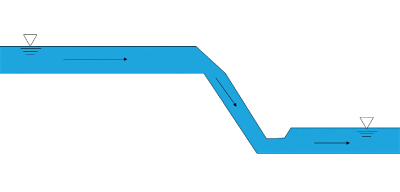
Longitudinal section of a series of drop structures
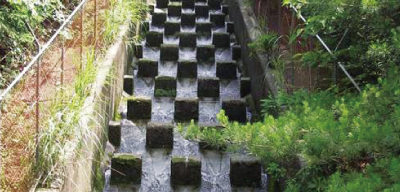
Drop structures
Next, let us briefly explain a pipeline system.
7) Pipelines
For pipelines, varieties of materials are used, such as steel, reinforced plastic, and concrete. Water taken from a river can be delivered to a higher-elevated place through a pipeline system, applying pressure from a pump at a pumping station. As water pressure increases in the pipeline at the time of water conveyance, the pipe requires water tightness and the strength against the water pressure. To absorb the pressure surge at the time of sudden pump stop, surge tanks* or regulating tanks are necessary on the way of the pipeline.
*A surge tank: It is a regulating facility to prevent the damage on the pipeline. Its key function is to release the abrupt increasing pressure inside of the tank upward at the time of operation of the valve located in the middle of the pipeline.
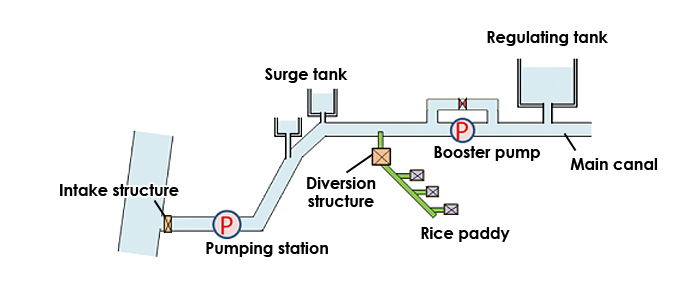
Schematic-cross section of the pipeline system
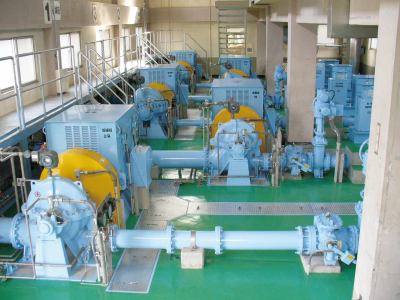
A pumping station
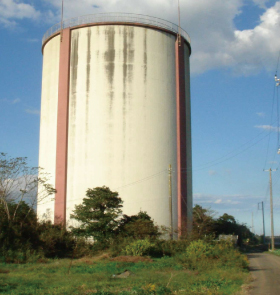
A regulating tank

















